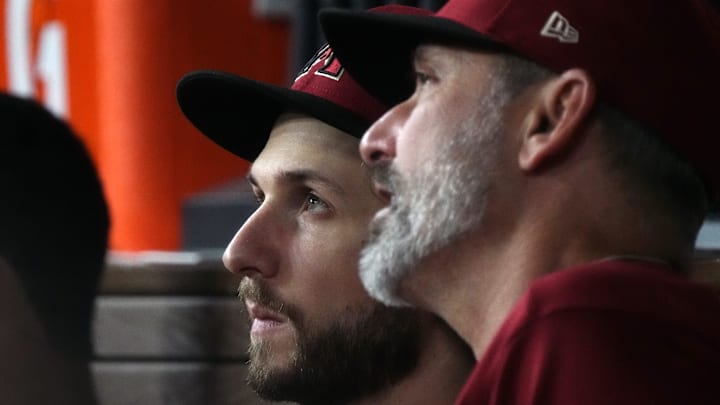Lovullo Did the Right Thing Pulling Gallen from No-Hitter

Zac Gallen pitched a magnificent game for the Arizona Diamondbacks in their 6-4 victory over the San Francisco Giants at Oracle Park Wednesday night. Overcoming some early wildness in the second inning, in which he walked the bases loaded, Gallen went on to complete six no-hit, shutout innings.
With Gallen's pitch count at an even 100, there was no chance he could go three more innings and finish off the complete game no-hitter. That would have taken at least 140 or more pitches, which is outside the realm of possibility for any pitcher in the modern game.
No pitcher in MLB has even thrown 120 pitches in 2024. There have been only been four pitchers to throw 115 or more. Toronto's Kevin Gausman threw 118 pitches in a complete game on July 27th. That's the highest pitch total by any pitcher in 2024.
As soon as Gallen was pulled from the game the chorus of complaints and criticism began to cascade from all corners of social media. But those criticisms are not in tune with the current state of Major League Baseball.
Gallen and Lovullo could be seen talking at the end of the dugout after the sixth inning. Following the game Lovullo said "He knew that there was no chance of throwing a no-hitter. I said look, if you had 70 pitches we'd be having a different conversation, and I said that's it"
"He understood, he was right in line with it. There was no way I was going to let him throw 145 pitches to throw a no-hitter. You can mark that one off the list. It will never happen here"
There have been three no-hitters in MLB this year. Ronel Blanco managed to complete his no-hitter with 105 efficient pitches. He only walked two, and struck out seven. He got 20 outs on balls in play. Dylan Cease and Blake Snell each needed 114 pitches to complete their no-hitters. They each walked three and struck out nine and 11 batters respectively.
Beyond that there have been 12 instances where a pitcher went at least five no-hit innings but ended up getting pulled before the eighth inning and was not allowed to go further. Ironically, one of them also came Wednesday night, in Chicago.
Shota Imanaga went seven no-hit innings on 95 pitches for the Cubs. His bullpen completed the no-hitter, the first in Wrigley Field in 52 years. Below is a full list of the 12 times this year a pitcher has been pulled from a game before allowing a hit. (Minimum five innings pitched) Original Table from Stathead
Over the course of the last three seasons there have actually been 45 such games where a starter went at least five innings but was pulled before the ninth inning without allowing a hit. So this is actually quite a common occurrence.
While some may lament the way Major League Baseball, and specifically starting pitching, has evolved over the decades, Lovullo was well within industry standards in his actions. To leave Gallen in for however long it took to complete a no-hitter would have been wreckless and a firable offense.
There are legitimate questions about how pitchers are conditioned and the reasons behind the emphasis on velocity. Clearly the typical pitch limit of 100 is not preventing injuries to starting pitchers, and that's often pointed out.
However increasing that workload is likely to just increase injuries even more. The core issue is that it takes higher velocity than years past to survive and thrive in the modern game. The physiology of the vast majority of pitchers is simply not compatible with throwing 93-100 MPH at maximum effort for any extended period of time.
Until something in the game changes to reverse decades long trends however, pitchers are going to continue to be limited in their workload. Training regimens are not going to change overnight, nor are the basic dynamics of the game that have evolved towards power.
Related Content: Starter's Workload: Stop Blaming Analytics for 122 Year Trend
Fifty-sixty years ago most teams had two or three batters that could take a pitcher deep on a consistent basis. Every once in a while a great lineup would come along with four or five power hitters. And those teams won. Most of the other team's lineups were filled with four or five hitters that were choking up on the bat and just trying to slap the ball in play.
That allowed starting pitchers to avoid going "max effort" to navigate most of a lineup. Pitchers regularly spoke of "dialing it up" when they needed to, and then going less than maximum effort against the weaker hitters in the lineup.
But in the modern game, every team has seven or eight hitters in the lineup that can take a pitcher deep on any mistake pitch left over the middle. The hitters are bigger, stronger, and have more streamlined hitting mechanics geared towards handling velocity.
Traditionalists like to point to lower batting averages as evidence that modern hitters are inferior or less skilled.
That simply isn't true. Rather it's a cycle of incentives. Pitchers throw harder, so approaches changed. It's harder to get a hit, so the incentive is to make those hits count, thus more batters willing to sacrifice contact for power.
The circular arguments are endless. "Look at batting averages, the hitters are worse than years past." But the people making those arguments also insist the pitchers are worse too. Is everyone in the modern game inferior to athletes who competed 50-60 years ago?
That's simply not logical. Major League Baseball may continue to attempt to tweak the rules here and there to nudge the game in a direction they feel is more desirable. But the reality is none of those changes are going to alter the trajectory. Evolution happens naturally.
In the meantime, this writer, who has watched and followed major league baseball since 1968, will continue to enjoy what is still the best game in the world. I'll marvel and wonder at the skill and athleticism of the people who play it at the highest level. That will never change.
